烟草幼苗根系分泌自毒物质种类及PAEs对根系抗氧化性能的影响
2017-02-08邓家军张仕祥张富生张艳玲李辉信
邓家军,张仕祥,张富生,张艳玲,胡 锋,李辉信,*
1 南京农业大学资源与环境科学学院土壤生态实验室,南京 210095 2 江西省农产品质量安全检测中心,南昌 330046 3 中国烟草总公司郑州烟草研究院,郑州 450001
烟草幼苗根系分泌自毒物质种类及PAEs对根系抗氧化性能的影响
邓家军1,2,张仕祥3,张富生2,张艳玲3,胡 锋1,李辉信1,*
1 南京农业大学资源与环境科学学院土壤生态实验室,南京 210095 2 江西省农产品质量安全检测中心,南昌 330046 3 中国烟草总公司郑州烟草研究院,郑州 450001
采用GC-MS技术鉴定水培烟草Burley及K326在幼苗期不同生长阶段的根系分泌物;并用不同浓度邻苯二甲酸二丁酯(DBP)、邻苯二甲酸二异辛酯(DIOP)溶液浇灌盆栽烟草幼苗,研究其根系抗氧化性能变化。结果如下:(1)Burley根系分泌物主要有3类化合物,其中自毒物质邻苯二甲酸酯(PAEs)在二叶龄期、四叶龄期、六叶龄期的相对含量分别为7.6%、0.3%、未检出;而K326根系分泌物主要有9类化合物,PAEs在二叶龄期、四叶龄期、六叶龄期的相对含量分别为35.6%、51.3%、2.2%。(2)浓度高于0.1 mmol/L的PAEs使根中超氧阴离子自由基产生的速率显著(P<0.05)增加;随着DIOP及DBP浓度的增加,超氧化物歧化酶、过氧化氢酶活性增加,在0.5 mmol/L时达到最大,然后随着处理浓度的增加而下降。丙二醛的浓度随着这两种PAEs处理浓度的增加而增大。结果表明:烟草根系分泌的自毒物质PAEs达到0.5 mmol/L时,能降低根系的抗氧化性能,造成根尖细胞膜系统的氧化损伤,引起根吸收功能等一系列生理生化变化,并最终表现出自毒作用。
烟草;根系分泌物;自毒物质;抗氧化酶活性
烟草(NicotianatabacumL.)属于茄科(Solanaceae),烟草属(Nicotiana)植物,是我国重要的经济作物之一。但随着耕地面积减少,加之种植制度、经济效益等因素影响,我国烟草连作问题相当突出。烟草长期连作,其根系分泌的某些物质在土壤中累积到一定浓度时,会对作物本身产生毒害[1-2],这就是烟草的自毒作用。自毒作用直接危害植株正常的生长发育,使烟叶产量及品质下降[3-4],是烟草产生连作障碍的主要原因之一。
植物的自毒作用通常发生在幼苗阶段,因为幼苗很脆弱,容易受到自毒物质的影响[5]。目前,直接评价植物自毒作用的文献较少:Jia等[6]研究了连作烟草产生的自毒物质对种子活力、幼苗根系活力、根系的长度及数量、幼苗高度及生物量的影响。Sun等[7]研究了番茄的自毒物质对其生长、抗氧化酶活力及光合作用的影响。刘苹等[8]研究结果显示,当土壤中自毒物质长链脂肪酸含量达到一定浓度时,对花生植株的生长和土壤酶活性能产生显著地抑制作用。郭亚利等[9]研究表明,烟草根系分泌物能显著降低其幼苗根系活力及对营养元素的吸收,且分泌物的不同组分的抑制效应存在显著差异,推测烟草根系分泌物中含有多种自毒物质。Yeasmin等[10]在连续移栽系统中以不同轮作方式培养两种芦笋(AsparagusofficinalisL.),发现所产生的自毒物质(草酸、琥珀酸和酒石酸等)对芦笋根和芽的生长及营养物质(P、N、K、Ca、Mg)的吸收产生不同程度的抑制作用。而环境中的pH值降低更易使根细胞膜脂受到伤害[11],Mazzoleni等[12]认为植物残体对同物种的抑制作用有两种:一种是由残体腐解出的不稳定的自毒物质所产生的非特异性抑制,另一种是由残体的DNA发起的特异性抑制。但烟草幼苗期各生长阶段自毒物质的分泌特征及自毒机制尚不明确。本研究拟对两个烟草品种Burley及K326幼苗期不同生长阶段的根系分泌物进行分离鉴定,并研究主要自毒物质对土培烟草根系中超氧阴离子产生的速率、抗氧化酶活性、脂质过氧化等的影响,从生理生化方面阐明烟草自毒作用可能的生理机制。此研究将对深入研究烟草根系分泌物中自毒物质的作用机理、减弱乃至消除烟草的自毒作用等方面具有重要意义。
1 材料与方法
1.1 供试植物
烟草Burley和K326的种子,由中国烟草总公司郑州烟草研究院提供。
1.2 幼苗期烟草根系分泌物的鉴定
1.2.1 收集根系分泌物
预培养烟草Burley及K326的种子,出芽后,分别放入装有适量无琼脂MS培养基的玻璃培养皿中。无琼脂MS 培养基成分为:
(1)大量元素 1.65 g NH4NO3,1.9 g KNO3,0.37 mg MgSO4·7H2O,0.17 g KH2PO4,0.44 g CaCl2·2H2O;
(2)微量元素 22.3 mg MnSO4·4H2O,0.83 mg KI,0.025 mg CuSO4·5H2O,6.25 mg H3BO5,0.025 mg CoCl·6H2O,8.65 mg ZnSO4·7H2O,0.25 mg Na2MoO4·2H2O;
铁盐 27.8 mg FeSO4·7H2O,37.3 mg Na2EDTA;
蔗糖30 g于1 L水中,用Tris调节pH至5.70,高压灭菌20 min[13]。
每个培养皿放入20颗,每种烟草设3个平行。然后将培养皿放入22—26 ℃、16 h光照/8 h黑暗的光照培养箱中,每天更换1次培养基。当幼苗生长至2叶龄期、4叶龄期及6叶龄期时,分别将3个时期的烟苗从培养皿中的培养基中取出,冲洗干净后,放入去离子水中。分泌24 h后再将烟苗放回培养基中,收集含有根系分泌物的去离子水。
1.2.2 pH值测定
采用pH值测定仪(BPH-200D, 上海益伦环境科技有限公司),测定收集烟草幼苗各叶龄期根系分泌物时的培养基pH值。
1.2.3 测试样品的制备
取50 mL含有烟草幼苗根系分泌物的水样及100 mL 正己烷,倒入250 mL分液漏斗中,振荡30 min,静置。分层后,将有机相通过装有无水硫酸钠的玻璃漏斗,接入旋转蒸发瓶中。水相再萃取1次,有机相转入旋转蒸发瓶,然后于45 ℃水浴中旋转蒸发至干,正己烷定容至2 mL,过0.22 μm滤膜,经硅烷化处理后于 -20 ℃下保存待测。
1.2.4 GC-MS检测
检测仪器:气质联用仪450GC-320MS(Bruker Daltonics Inc., USA)。
色谱条件:DB-5MS 色谱柱(Agilent 19091S-433, HP-5MS, 5% Phenyl Methyl Siloxane,30 m×0.25 mm×0.25 μm,美国安捷伦公司);进样口温度250 ℃;程序升温:柱温 70 ℃保持4 min,以5 ℃/min升温至130 ℃,保持5 min,再以10 ℃/min升至250 ℃,保持15 min;质谱接口温度为270 ℃;载气为He,流速为1.0 mL/min。
质谱条件:EI源,-70 eV;扫描范围为m/z 50—500 amu;扫描时间为0.5 s;离子源温度为200 ℃;四级杆温度为150 ℃;传输线温度220 ℃。
进样方式:不分流进样,进样量为1 μL。
与标准质谱谱库Wiley 7n.L 及NIST 05.L比对,确定各种化合物,采用面积归一化法(JY/T003—1996)计算其相对含量。
1.3 邻苯二甲酸酯(PAEs)对烟草根系抗氧化酶活性的影响
将6片真叶的K326幼苗移栽至直径11 cm,1.5 L的瓦盆中,内装有取自河南省郑州市郊土壤(表1)。每盆中移栽1株,随机置于温室中:每天光照16 h,有效辐射为320 μmol m-2s-1,温度范围为35 ℃/25 ℃(昼/夜),相对湿度为60%[14]。在幼苗正常生长后,每星期浇100 mL用邻苯二甲酸二丁酯(DBP)、邻苯二甲酸二异辛酯(DIOP) (优级纯,Aladdin试剂有限公司,中国上海) 分别配制0、0.01、0.1、0.5、1.0、5.0 mmol/L及10.0 mmol/L 6个浓度梯度溶液,浓度参照烟草连作土壤中检测的浓度设置的[15],每个梯度有3个重复,连续浇5周。然后采集植株根系,洗净、晾干后备用。

表1 供试土壤的基本理化性质

1.4 数据分析
采用SPSS 16.0 (SPSS Inc., Chicago, USA) 的One-way ANOVA分析不同处理之间的差异性(P<0.05)。同一梯度3个重复,用于计算平均值和标准偏差。
2 结果
2.1 根系分泌物的鉴定
2.1.1 Burley幼苗期根系分泌物
Burley幼苗期根系分泌物主要有3类(表2)。其中2叶龄期主要分泌2类物质:
(1)烷烃;(2) 邻苯二甲酸酯: 邻苯二甲酸二异丁酯(DIBP)、邻苯二甲酸3-己基异丁酯。
Burley 4叶龄期主要分泌3类物质:(1)烷烃;(2) 邻苯二甲酸酯: 邻苯二甲酸异丁基壬酯;(3) 2-甲氧基苯酚。
Burley 6叶龄期主要分泌2类物质:(1) 烷烃;(2)邻苯二甲酸酯: 邻苯二甲酸4-庚基异丁酯。
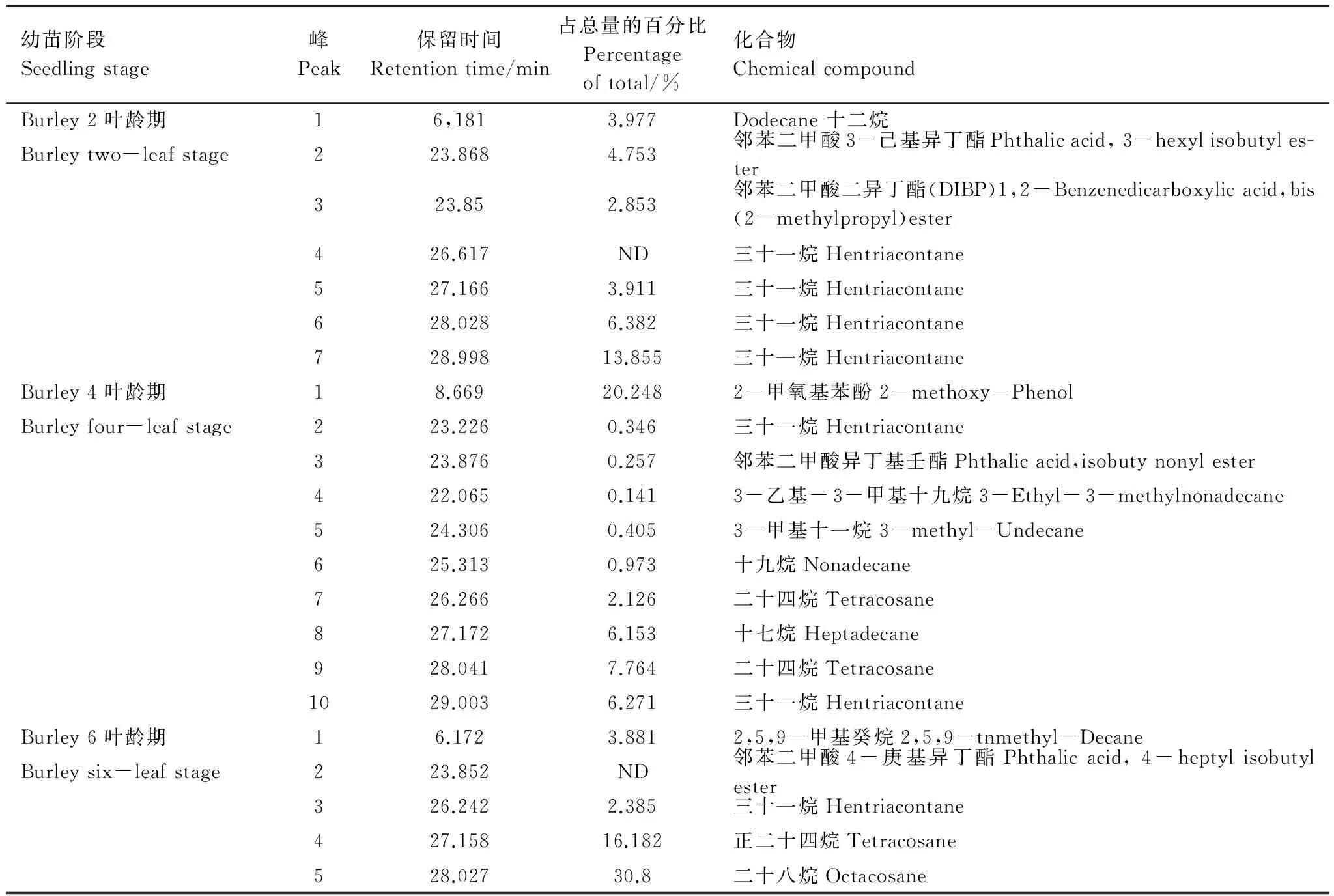
表2 Burley幼苗不同阶段的根系分泌物
ND: not detected
2.1.2 K326幼苗期根系分泌物
K326幼苗期根系分泌物主要有9类(见表3)。其中,2叶龄期根系分泌物中主要含有 7类物质:(1) 烷烃;(2) 邻苯二甲酸酯:DIOP、邻苯二甲酸二正辛酯(DOP)、邻苯二甲酸丁基环己酯 (BCHP);(3) 二十三烷酸甲酯;(4) 十二烷基-三苯基溴化磷;(5) 1,4-二醇, 2, 3-二甲基-5-三氟甲基苯;(6) 十一丁基亚硫酸酯;(7) 反油酸-苄基二甲硅基脂。
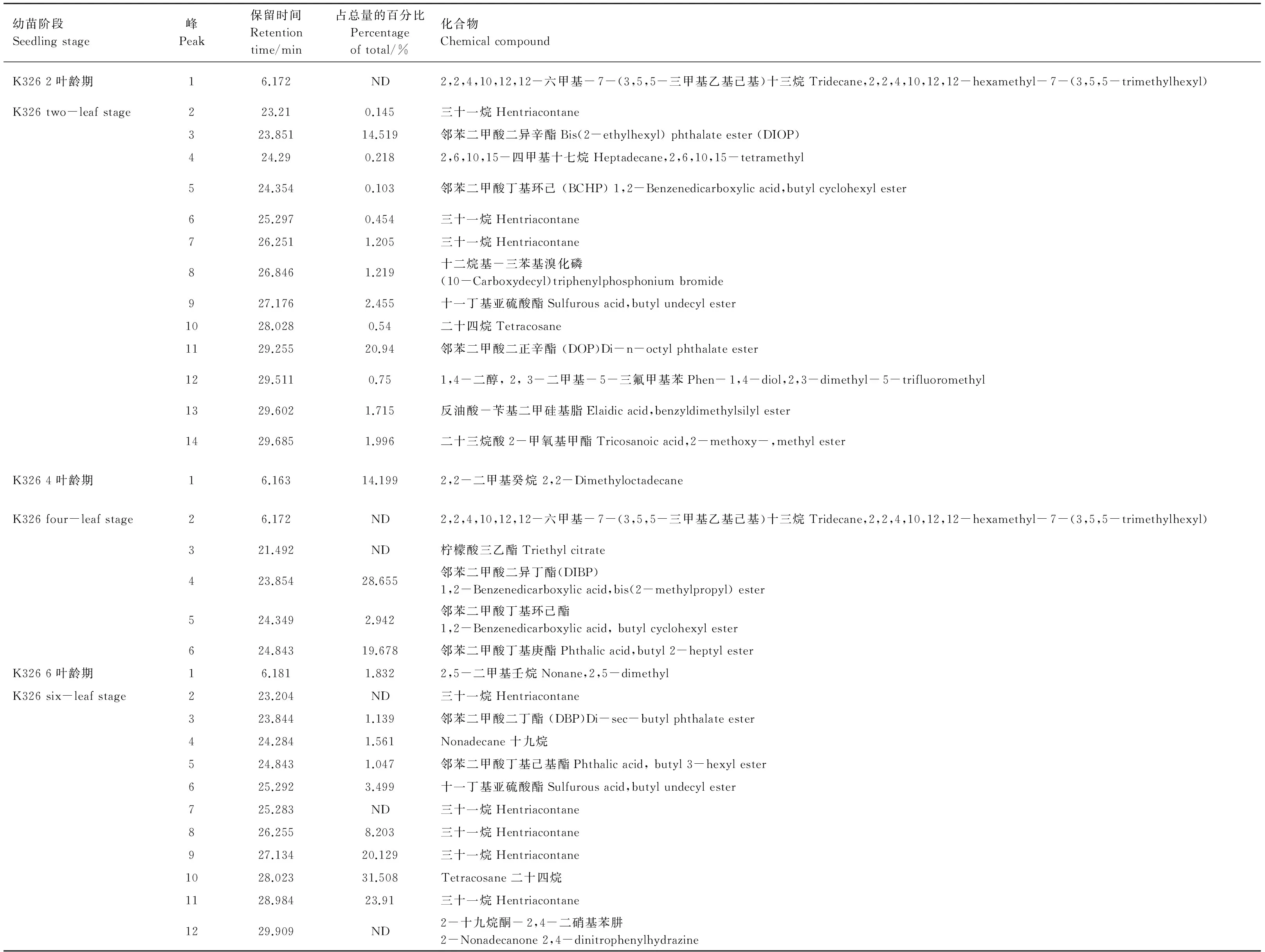
表3 K326幼苗不同阶段的根系分泌物
ND: not detected
K326 4叶龄期根系分泌物中主要含有3类物质:(1) 烷烃;(2) 邻苯二甲酸酯: DIBP、邻苯二甲酸丁基环己酯、邻苯二甲酸丁基庚酯; (3) 柠檬酸三乙酯。
K326 6叶龄期主要含有4类物质:(1) 烷烃;(2) 邻苯二甲酸酯:DBP、邻苯二甲酸丁基己基酯;(3) 2-十九烷酮-2,4-二硝基苯肼;(4)十一丁基亚硫酸酯。
常见的自毒物质主要有水溶性有机酸、直链醇、脂肪族醛与酮、简单不饱和内酯、长链脂肪酸与多炔、蒽醌与复合醌、简单酚、苯甲酸及其衍生物、肉桂酸及其衍生物、香豆素类、类黄酮、单宁、类萜及甾类化合物、氨基酸及多肽、生物碱与氰醇、硫化物与芥子油苷、嘌呤及核苷等[20-22]。在Burley幼苗期根系分泌物中具有自毒作用的是邻苯二甲酸酯及二甲氧基苯酚。邻苯二甲酸酯在二叶龄期及四叶龄期所占的比率分别为7.6%及0.3%,而在六叶龄期未检出邻苯二甲酸酯。在K326幼苗期根系分泌物中具有自毒作用的是邻苯二甲酸酯,分别在二叶龄期、四叶龄期、六叶龄期所占的比率为35.6%、51.3%、2.2% 。具有潜在自毒作用的是烷酸酯、柠檬酸三乙酯等。
2.2 烟草幼苗不同叶龄期培养基pH值
烟草幼苗不同叶龄期培养基pH值如表4。本试验用于培养烟草幼苗的MS无琼脂培养基pH为5.70。Burley与K326两种烟草幼苗各个叶龄期培养基的pH值都比培养前低。两种烟草幼苗随着叶龄期的增加,培养基的pH值升高,但都比培养前低。

表4 Burley与K326幼苗不同叶龄期培养基的pH值
表中不同字母表示烟草幼苗不同叶龄期培养基pH值在P<0.05水平上差异显著,数据为平均值±标准差(n=3)
2.3 两种肽酸酯对烟草根系抗氧化活性的影响
2.3.2 两种肽酸酯对SOD活性的影响
烟草根系SOD活性随着DBP浓度的增加而升高。而SOD活性随着DIOP浓度的增加分别在0.5 mmol/L时达到最大,然后随着DIOP浓度的增大而降低(图2)。两种试剂处理对SOD活性影响有显著性差异(P<0.05)。
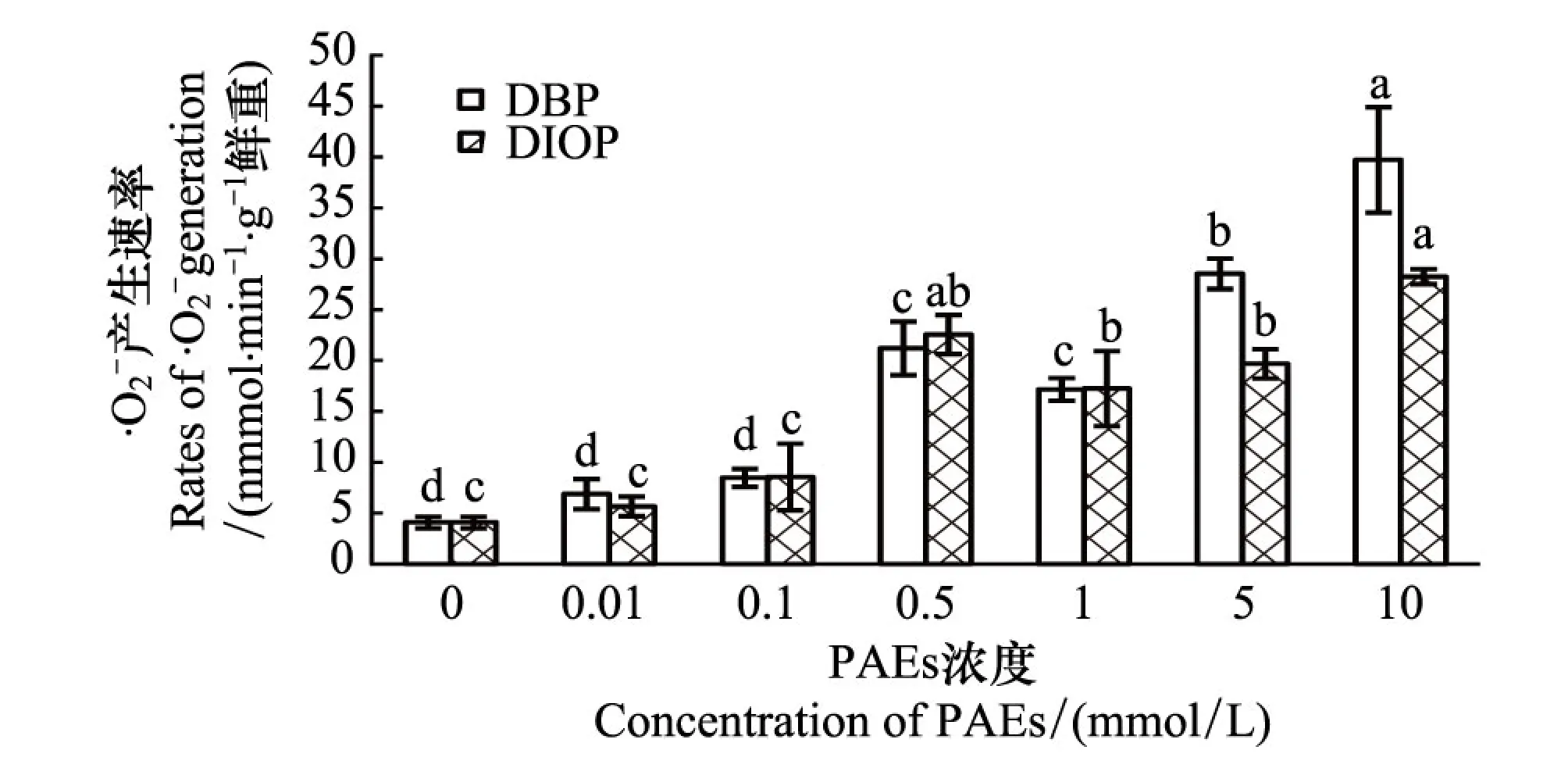
图1 两种肽酸酯对烟草根系产生速率的影响Fig.1 Effects of two phthalate esters on rates of generation in tobacco roots图中不同字母表示相同处理不同PAE浓度在P<0.05水平上差异显著,数据为平均值±标准差(n=3);DBP:邻苯二甲酸二丁酯dibutyl phthalate;DIOP:邻苯二甲酸二异辛酯 diisooctyl phthalate
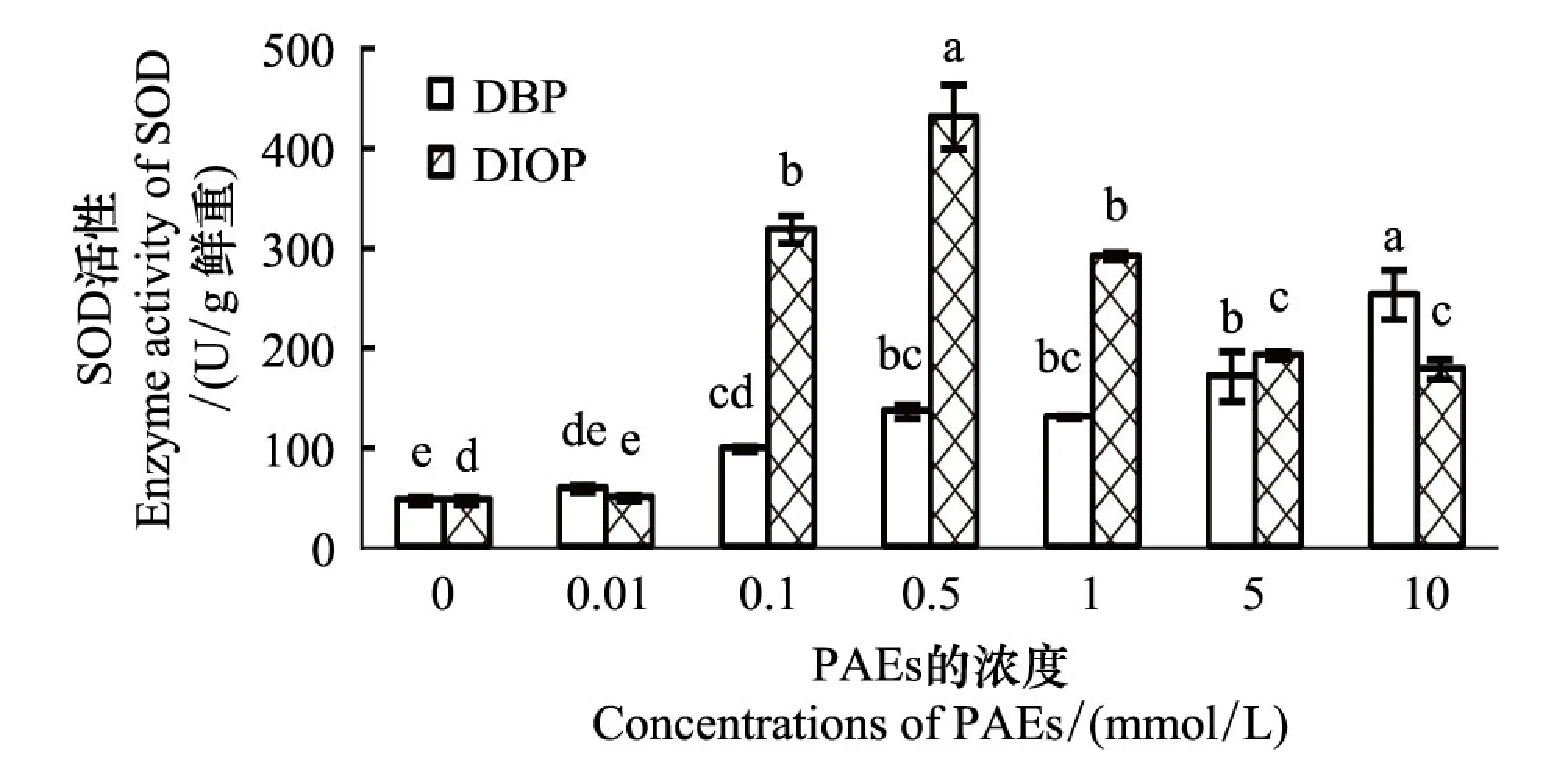
图2 两种肽酸酯对烟草根系中SOD活性的影响Fig.2 Effect of two phthalate esters on SOD activity in tobacco roots图中不同字母表示相同处理不同PAE浓度在P<0.05水平上差异显著,数据为平均值±标准差(n=3);DBP:邻苯二甲酸二丁酯 dibutyl phthalate;DIOP:邻苯二甲酸二异辛酯 diisooctyl phthalate
2.3.3 两种肽酸酯对CAT活性的影响
烟草根系CAT活性随着DIOP浓度的增加而急剧升高。可是,随着DBP浓度的增加,CAT的活性在0.5 mmol/L时达到最大,然后下降至与对照相似的水平(图3)。两种试剂处理对CAT活性影响有显著性差异(P<0.05)。
2.3.4 两种肽酸酯对烟草根系MDA含量的影响

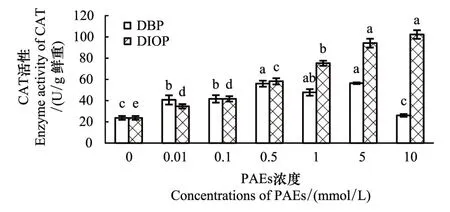
图3 两种肽酸酯对烟草根系中CAT活性的影响Fig.3 Effects of two phthalate esters on CAT activity in tobacco roots图中不同字母表示相同处理不同PAE浓度在P<0.05水平上差异显著,数据为平均值±标准差(n=3);DBP (dibutyl phthalate):邻苯二甲酸二丁酯;DIOP (diisooctyl phthalate):邻苯二甲酸二异辛酯
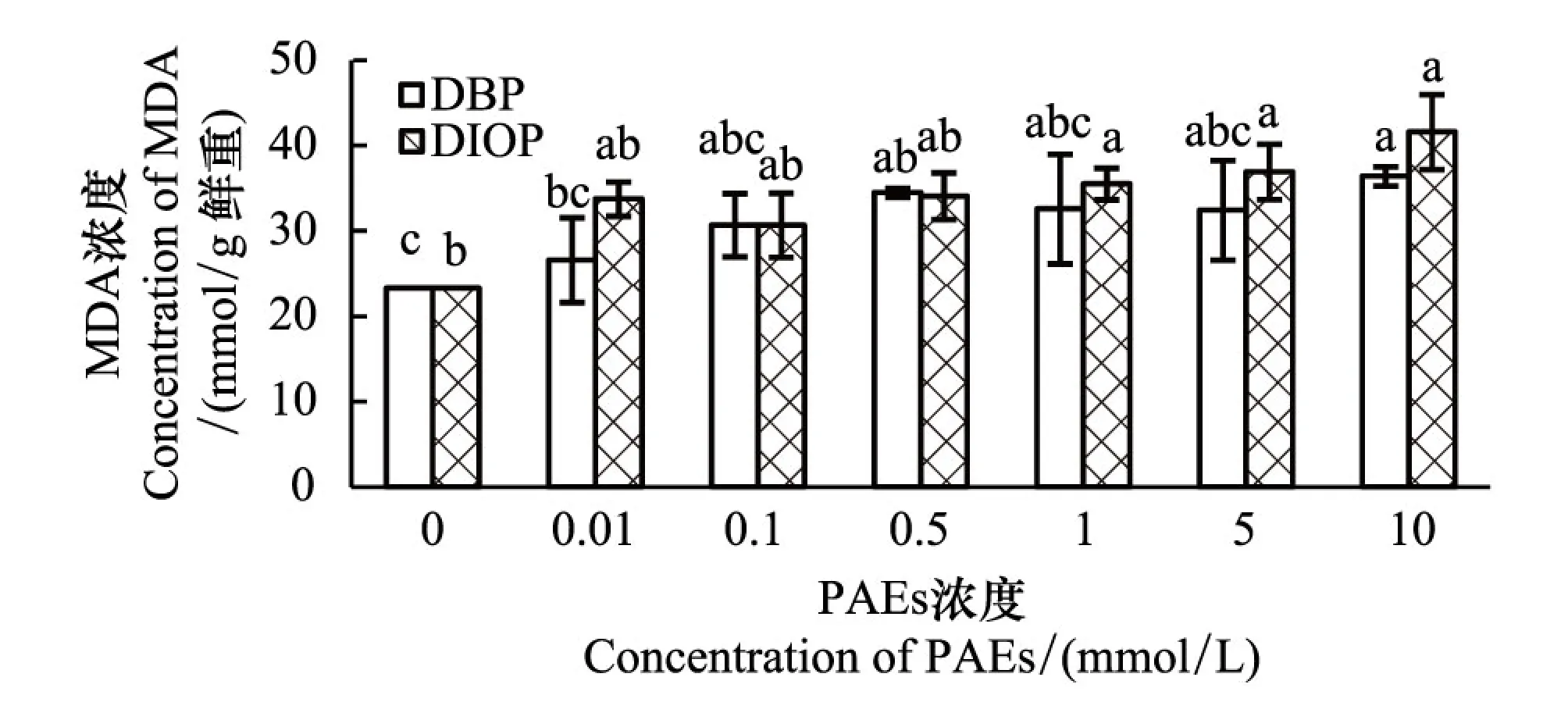
图4 两种肽酸酯对烟草根系中MDA 浓度的影响Fig.4 Effects of two phthalate esters on the concentration of MDA in tobacco roots图中不同字母表示相同处理不同PAE浓度在P<0.05水平上差异显著,数据为平均值±标准差(n=3);DBP:邻苯二甲酸二丁酯 dibutyl phthalate:;DIOP:邻苯二甲酸二异辛酯 diisooctyl phthalate
3 讨论
自毒作用是个体间为了利用有限的资源而进行的一种特殊形式的种内竞争,结果会导致竞争个体适合度的下降,通常表现为密度制约或自疏现象[23]。这将会调解种群数量,使种群由较健康、有活力、更适合周围环境、避免种内竞争的较大个体组成,这样的种群有利于自然选择[24]。



4 结论
烟草Burley及K326在幼苗期的不同叶龄期根系分泌物的种类及相对含量是不同的:Burley幼苗期根系分泌物主要有3种,K326幼苗期根系分泌物主要有9种。两种烟草不同叶龄期根系分泌物的种类和相对含量有显著性差别。而且这两种烟草都能产生自毒物质PAEs,及潜在自毒物质烷酸酯等。在烟草幼苗在生长过程中,所产生的PAEs的相对含量逐渐减少。
[1] Walker T S, Bais H P, Grotewold E, Vivanco J M. Root exudation and rhizosphere biology. Plant Physiology, 2003, 132(1): 44-51.
[2] Xie X N, Kusumoto D, Takeuchi Y, Yoneyama K, Yamada Y, Yoneyama K. 2′-epi-orobanchol and solanacol, two unique strigolactones, germination stimulants for root parasitic weeds, produced by tobacco. Journal of Agricultural and Food Chemistry, 2007, 55(20): 8067-8072.
[3] 晋艳, 杨宇虹, 段玉琪, 龙玉华, 叶成碧. 烤烟连作对烟叶产量和质量的影响研究初报. 烟草科技, 2002, (1): 41-45.
[4] 邓阳春, 黄建国. 长期连作对烤烟产量和土壤养分的影响. 植物营养与肥料学报, 2010, 16(4): 840-845.
[5] Weir T L, Park S W, Vivanco J M. Biochemical and physiological mechanisms mediated by allelochemicals. Current Opinion in Plant Biology, 2004, 7(4): 472-479.
[6] Jia Z H, Yi J H, Su Y R, Shen H. Autotoxic substances in the root exudates from continuous tobacco cropping. Allelopathy Journal, 2011, 27(1): 87-96.
[7] Sun Y Y, Jiang G Y, Wei X C, Liu J G. Autotoxicity effects of soils continuously cropped with tomato. Allelopathy Journal, 2011, 28(2): 135-144.
[8] 刘苹, 赵海军, 仲子文, 孙明, 庞亚群, 马征, 万书波. 三种根系分泌脂肪酸对花生生长和土壤酶活性的影响. 生态学报, 2013, 33(11): 3332-3339.
[9] 郭亚利, 李明海, 吴洪田, 袁玲, 黄建国. 烤烟根系分泌物对烤烟幼苗生长和养分吸收的影响. 植物营养与肥料学报, 2007, 13(3): 458-463.
[10] Yeasmin R, Nakamatsu K, Matsumoto H, Motoki S, Nishihara E, Yamamoto S. Inference of allelopathy and autotoxicity to varietal resistance of asparagus (AsparagusofficinalisL.), Australian Journal of Crop Science, 2014, 8(2): 251-256.
[11] Liu P, Wan S B, Jiang L H, Wang C B, Liu Z H, Zhao H J, Yu S F, Yang L. Autotoxic potential of root exudates of peanut (ArachishypogaeaL.). Allelopathy Journal, 2010, 26(2):197-205.
[12] Mazzoleni S, Bonanomi G, Incerti G, Chiusano M L, Termolino P, Mingo A, Senatore M, Giannino F, Cartenì F, Rietkerk M, Lanzotti V. Inhibitory and toxic effects of extracellular self-DNA in litter: a mechanism for negative plant-soil feedbacks?. New Phytologist, 2015, 205(3): 1195-1210.
[13] Murashige T, Skoog F. A revised medium for rapid growth and bio-assays with tobacco tissue cultures. Physiologia Plantarum, 1962, 15(3): 473-497.
[14] Walch-Liu P, Neumann G, Bangerth F, Engels C. Rapid eects of nitrogen form on leaf morphogenesis in tobacco. Journal of Experimental Botany, 2000, 51(343): 227-237.
[15] Yi J H, Jia Z H, Lin Q, Lv H Z, Shen H. Allelopathic effects of decaying tobacco leaves on tobacco seedlings. Allelopathy Journal, 2012, 29(1): 51-61.
[16] Dhindsa R S, Matowe W. Drought tolerance in two mosses: correlated with enzymatic defence against lipid peroxidation. Journal of Experimental Botany, 1981, 32(1): 79-91.
[17] Beers R F Jr, Sizer I W. A spectrophotometric method for measuring the breakdown of hydrogen peroxide by catalase. The Journal of Biological Chemistry, 1952, 195(1): 133-140.
[18] Heath R L, Packer L. Photoperoxidation in isolated chloroplast. I. Kinetics and stochiometry of fatty acid peroxidation. Archives of Biochemistry and Biophysics, 1968, 125(1): 189-198.
[19] Elstner E F, Heupel A. Formation of hydrogen peroxide by isolated cell walls from horseradish (ArmoracialapathifoliaGilib.). Planta, 1976, 130(2): 175-180.
[20] Tang C S, Takenaka T. Quantitation of a bioactive metabolite in undisturbed rhizosphere-benzyl isothiocyanate FromCaricaPapayaL. Journal of Chemical Ecology, 1983, 9 (8):1247-1253.
[21] Rice E L. Allelopathy. 2nd ed. Orlando, Florida: Academic Press, 1984.
[22] Inderjit. Plant phenolics in allelopathy. The Botanical Review, 1996, 62(2):186-202.
[23] Weller D E. The interspecific size-density relationship among crowded plant stands and its implications for the -3/2 power rule of self-thinning. The American Naturalist. 1989, 133(1): 20-41.
[24] Singh H P, Batish D R, Kohli R K. Autotoxicity: concept, organisms, and ecological significance. Critical Reviews in Plant Sciences, 1999, 18(6): 757-772.
[25] Inderjit, Callaway R M, Vivanco J M. Can plant biochemistry contribute to understanding of invasion ecology? Trends in Plant Science, 2006, 11(12): 574-580.
[26] Kato-Noguchi H. Allelopathic substance in rice root exudates: Rediscovery of momilactone B as an allelochemical. Journal of Plant Physiology, 2004, 161(3): 271-276.
[27] El-Halmouch Y, Benharrat H, Thalouarn P. Effect of root exudates from different tomato genotypes on broomrape (O.aegyptiaca) seed germination and tubercle development. Crop Protection, 2006, 25(5): 501-507.
[28] Neumann G, Massonneau A, Martinoia E, Römheld V. Physiological adaptations to phosphorus deficiency during proteoid root development in white lupin. Planta, 1999, 208(3): 373-382.
[29] Tyler G, Ström L. Differing organic acid exudation pattern explains calcifuge and acidifuge behaviour of plants. Annals of Botany, 1995, 75(1): 75-78.
[30] Schumacher W J, Thill D C, Lee G A. Allelopathic potential of wild oat (Avenafatua) on spring wheat (Triticumaestivum) growth. Journal of Chemical Ecology, 1983, 9(8): 1235-1245.
[32] 屠振力, 钟儒杰. 环境激素邻苯二甲酸丁基苄酯对家蚕生殖的影响. 生态学报, 2014, 34(19): 5470-5476.
[33] Alías J C, Sosa T, Escudero J C, Chaves N. Autotoxicity against germination and seedling emergence inCistusladaniferL. Plant and Soil, 2006, 282(1/2): 327-332.
[34] Ma Y Q, Jia J N, An Y, Wang Z, Mao J C. Potential of some hybrid maize lines to induce germination of Sunflower Broomrape. Crop Science, 2013, 53(1): 260-270.
[35] Foyer C H, Descourvières P, Kunert K J. Protection against oxygen radicals: an important defence mechanism studied in transgenic plants. Plant, Cell & Environment, 1994, 17(5): 507-523.
[36] Halliwell B, Gutteridge J M C. Free radicals in biology and medicine. 4th ed. Oxford: Glarendon Press, 1985.
[37] Papadakis A K, Roubelakis-Angelakis K A. The generation of active oxygen species differs in tobacco and grapevine mesophyll protoplasts. Plant Physiology, 1999, 121(1): 197-206.
[38] 邓家军, 胡继伟, 李继新, 苏贤坤, 黄先飞, 刘峰. 重金属离子对烤烟叶片中铜锌超氧化物歧化酶活性的影响. 中国烟草学报, 2010, 16(3): 1-6.
[39] Mobin M, Khan N A. Photosynthetic activity, pigment composition and antioxidative response of two mustard (Brassicajuncea) cultivars differing in photosynthetic capacity subjected to cadmium stress. Journal of Plant Physiology, 2007, 164(5): 601-610.
[40] Van Camp W, INZÉ D, Van Montagu M. The regulation and function of tobacco superoxide dismutases. Free Radical Biology and Medicine, 1997, 23(3): 515-520.
[41] Willekens H, Chamnongpol S, Davey M, Schraudner M, Langebartels C, Van Montagu M, INZÉ D, Van Camp W. Catalase is a sink for H2O2and is indispensable for stress defense in C3plants. the EMBO Journal, 1997, 16(16): 4806-4816.
[42] Bais H P, Vepachedu R, Gilroy S, Callaway R M, Vivanco J M. Allelopathy and exotic plant invasion: from molecules and genes tospecies interactions. Science, 2003, 301(5638): 1377-1380.
[43] 李志萍, 张文辉, 崔豫川. NaCl和Na2CO3胁迫对栓皮栎种子萌发及幼苗生长的影响. 生态学报, 2015, 35(3): 742-751.
[44] Foyer C H, Lopez-Delgado H, Dat J F, Scott I M. Hydrogen peroxide-and glutathione-associated mechanisms of acclimatory stress tolerance and signalling. Physiologia Plantarum, 1997, 100(2): 241-254.
[45] Baziramakenga R, Leroux G D, Simard R R. Effects of benzoic and cinnamic acids on membrane permeability of soybean roots. Journal of Chemical Ecology, 1995, 21(9): 1271-1285.
[46] Ye S F, Zhou Y H, Sun Y, Zou L Y, Yu J Q. Cinnamic acid causes oxidative stress in cucumber roots, and promotes incidence ofFusariumwilt. Environmental and Experimental Botany, 2006, 56(3): 255-262.
[47] Yu J Q, Matsui Y. Effects of root exudates of cucumber (Cucumissativus) and allelochemicals on ion uptake by cucumber seedlings. Journal of Chemical Ecology, 1997, 23(3): 817-827.
Autotoxins exuded from roots and the effects of PAEs on antioxidant capacity in roots of tobacco seedlings
DENG Jiajun1,2, ZHANG Shixiang3, ZHANG Fusheng2, ZHANG Yanling3, HU Feng1, LI Huixin1,*
1SoilEcologyLaboratory,CollegeofResourcesandEnvironmentalSciences,NanjingAgriculturalUniversity,Nanjing210095,China2TestingCenterofAgro-ProductQualityandSafetyofJiangxiProvince,Nanchang330046,China3ZhengzhouTobaccoResearchInstitute,ChinaNationalTobaccoCorporation,Zhengzhou450001,China
Root exudates of two varieties (Burley and K326) of tobacco seedlings cultured in a hydroponic medium were collected, and identified using gas chromatography-mass spectrometry (GC-MS). Further, the effects of different concentrations of dibutyl phthalate (DBP) and diisooctyl phthalate (DIOP) on root antioxidant capacity were assessed using pot culture experiments. The results revealed three main compounds in Burley root exudates. The relative content of autotoxin phthalate esters (PAEs) at the two-, four-, and six-leaf stages were 7.6%, 0.3%, and not detected, respectively. However, there were nine main compounds in K326 root exudates. The relative PAE content at the two-, four-, and six-leaf stages were 35.6%, 51.3%, and 2.2%, respectively. PAEs such as DIOP and DBP were identified as the major autotoxins in root exudates of both tobacco seedlings. The rate of superoxide anion radical generation in roots significantly increased at concentrations greater than 0.1 mmol/L DIOP and DBP (P< 0.05). Both superoxide dismutase and catalase activities increased with increasing DIOP concentrations, with a peak at 0.5 mmol/L, and subsequently decreased at higher concentrations. Accumulated malondialdehyde concentrations increased with increasing DIOP and DBP concentrations, and the magnitude of malondialdehyde content was DIOP > DBP, which indicated the order of their toxic effect. Finally, our findings also revealed that when PAEs reached 0.5 mmol/L, they decreased the antioxidant capacity of the root system, initiated oxidative damage of the root cell membrane system, and caused a further decrease in root absorption and mineral metabolism, and thereby led to autotoxicity in the tobacco plants.
tobacco; root exudates; autotoxins; antioxidant enzyme activity
中国烟草总公司郑州烟草研究院科学技术合作项目(YKJSS201101)
2015-08-02;
日期:2016-06-13
10.5846/stxb201508021630
* 通讯作者Corresponding author.E-mail: huixinli@njau.edu.cn
邓家军,张仕祥,张富生,张艳玲,胡锋,李辉信.烟草幼苗根系分泌自毒物质种类及PAEs对根系抗氧化性能的影响.生态学报,2017,37(2):495-504.
Deng J J, Zhang S X, Zhang F S, Zhang Y L, Hu F, Li H X.Autotoxins exuded from roots and the effects of PAEs on antioxidant capacity in roots of tobacco seedlings.Acta Ecologica Sinica,2017,37(2):495-504.
